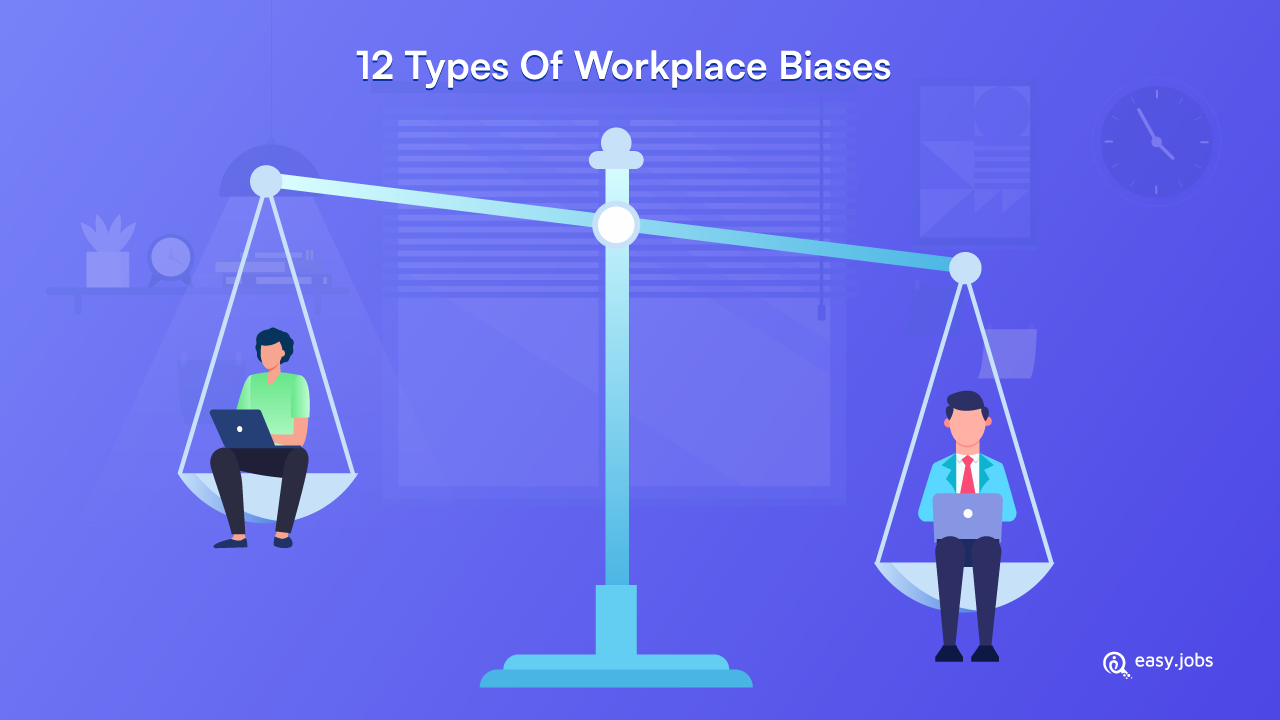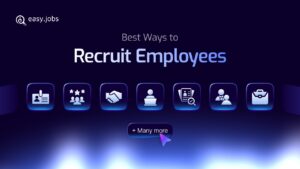In today’s dynamic workflow and professional culture, addressing various types of workplace bias has become crucial to fostering a genuinely productive environment. On top of that, understanding discrimination at different workplace layers is essential to promoting fairness, equality, and collaboration among employees.

In this comprehensive blog, let’s delve into 12 distinct types of workplace biases, explore their implications, and provide actionable strategies for addressing and reducing them effectively.
💡 Types Of Workplace Bias: The Detailed Know-How
Workplace bias refers to the presence of preconceived visions, attitudes, and preferences that influence how individuals interact with and make decisions about their colleagues or employees.
These biases can originate from a variety of factors, including cultural backgrounds, personal experiences, societal influences, and even unconscious thought processes. Multiple types of workplace bias can have far-reaching effects, affecting everything from recruitment and hiring to employee performance evaluations and opportunities for growth.
🧑💻 Key Takeaways Of Workplace Bias
👉 Types Abound: Workplace bias comes in various forms, including gender bias, ageism, affinity bias, and more.
👉 Unconscious Influence: Unconscious bias can impact decision-making without individuals realizing it.
👉 Diversity at Stake: Bias can hamper the establishment of a diverse and inclusive work environment.
👉 Challenges And Opportunities: Addressing and overcoming workplace bias can lead to enhanced collaboration and innovation.
👉 Creating Change: Strategies like training and awareness initiatives are crucial in mitigating bias.
As organizations strive for fairness and equity, addressing workplace bias is essential for fostering a prosperous professional environment.
🧑🏫 Different Types Of Workplace Bias & How You Can Address Them
Workplace bias surrounds various discriminatory behaviors and attitudes that can adversely affect employees’ experiences and career growth. By recognizing and addressing these biases in the first place, companies can create a more welcoming and equitable work environment for everyone.
📌 Affinity Bias
Affinity bias, sometimes referred to as similarity bias occurs when individuals naturally gravitate toward others with similar backgrounds, experiences, and interests. While connecting with like-minded colleagues is natural, it can inadvertently exclude others with diverse perspectives.
Addressing Affinity Bias: Encourage employees to actively aspire to diverse viewpoints, collaborate across teams, and engage in cross-functional projects. Implementing structured interview processes focusing on skills and qualifications rather than cultural fit can also help reduce affinity bias.
📌 Ageism
Types of workplace discrimination involve making judgments based on an individual’s age, often leading to discrimination against older or younger employees. This bias can impede collaboration, limit opportunities, and influence negative stereotypes.
Addressing Ageism: Develop training programs to promote age diversity awareness and challenge age-related stereotypes. Establish clear guidelines for evaluating employees based on their skills, performance, and potential rather than age.
📌 Attribution Bias
Types of bias in the workplace, like attribution bias, occur when people show specific traits or behaviors to individuals based on prior observations. This bias can lead to unfair judgments and impact decision-making.
Addressing Attribution Bias: Encourage open dialogue among team members to challenge assumptions and promote a culture of curiosity. When evaluating employees, focus on objective evidence and give individuals the opportunity to explain their actions or behaviors.
📌 Authority Bias
Types of bias at the workplace, such as authority bias, involve the tendency to prioritize opinions and ideas presented by individuals in positions of authority. While respecting leadership is essential, excessive deference can demotivate innovation and discourage diverse perspectives.

Addressing Authority Bias: Foster an environment where all employees feel motivated to contribute ideas and challenge existing norms. Implement regular feedback sessions that encourage open discussions between team members and leaders.
📌 Confirmation Bias
Types of unconscious bias in the workplace, like confirmation bias, involve seeking information that supports preexisting beliefs while ignoring contradictory evidence. This bias can hamper effective decision-making and lead to the rise of inaccurate stereotypes.
Addressing Confirmation Bias: Encourage critical thinking and the exploration of different viewpoints within your teams. Encourage employees to gather diverse sources of information and evaluate the data objectively before making a final choice.
📌 Gender Bias
Gender bias is discrimination based on an individual’s gender. This bias can limit opportunities for professional growth and hinder gender diversity in leadership positions.
Addressing Gender Bias: Implement gender-neutral policies, such as equal pay for equal work, and provide mentorship and leadership development opportunities for all genders. Create a safe space for employees to report gender bias and take appropriate action.
📌 Halo Effect
The halo effect involves building an overall positive impression of an individual based on an impressive quality or characteristic. It’s one of the types of unconscious bias in the workplace. While recognizing accomplishments is essential, overreliance on the halo effect can lead to overlooking areas for improvement.
Addressing the Halo Effect: Encourage a holistic evaluation of employees’ skills, contributions, and potential. Focus on providing constructive feedback and recognizing diverse strengths and accomplishments.
📌 Name Bias
Types of bias in the workplace, like name bias, occur when individuals make assumptions or judgments based on a person’s name, often leading to disparities in hiring and promotions. This bias affects individuals with less common characteristics or associated with specific cultures.

Addressing Name Bias: Implement blind recruitment practices that remove identifying information from applications and focus solely on qualifications. Train hiring managers to evaluate candidates based on skills and experience rather than names.
📌 Nonverbal Bias
Nonverbal bias involves judging individuals based on their body language, gestures, and appearance. This bias can lead to misinterpretations and hamper effective communication.
Addressing Nonverbal Bias: Promote awareness of nonverbal cues and their potential for misinterpretation. Encourage listening directly and provide effective communication technique training to enhance understanding and reduce bias.
📌 Perceptual Bias
Types of bias in the workplace, such as perceptual bias, refer to forming opinions about individuals based on their physical characteristics, such as race, ethnicity, or physical disabilities. This bias can keep stereotypes ongoing and lead to unequal treatment.
Addressing Perceptual Bias: Implement diversity and inclusion training programs that educate employees about the harmful effects of perceptual bias. Foster a culture of empathy and respect, emphasizing the value of diverse perspectives.
📌 Performance Bias
Performance bias involves underestimating or overestimating an individual’s overall capabilities based on their performance on specific tasks. This discrimination can result in missed opportunities for growth and development.
Addressing Performance Bias: Provide regular and constructive feedback to employees, focusing on their achievements and areas for improvement. Encourage a growth mindset that values continuous learning and development.
📌 Weight Bias
Types of workplace discrimination, like weight bias, occur when individuals make judgments based on an individual’s body weight, often leading to discrimination and negative stereotypes. This bias can contribute to a hostile work environment and impact mental well-being.
Addressing Weight Bias: Create a workplace culture that promotes body positivity, inclusivity, and respect for all body types. Offer wellness programs that focus on holistic health and well-being rather than solely on weight.
📈 Address WorkPlace Biases & Boost Productivity
As organizations strive for inclusivity and equality, addressing various types of workplace bias is vital. By acknowledging and actively countering biases such as affinity bias, ageism, attribution bias, and others, workplaces can become more diverse, collaborative, and innovative.
By fostering a culture of awareness, empathy, and continuous learning, businesses can create an environment where employees feel valued and empowered to reach their full potential and boost productivity.

If you have found this blog helpful, share your opinion with our Facebook community. You can subscribe to our blogs for valuable tutorials, guides, knowledge, tips, and the latest recruitment updates.





